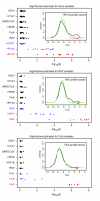E-Predict: a computational strategy for species identification based on observed DNA microarray hybridization patterns
- PMID: 16168085
- PMCID: PMC1242213
- DOI: 10.1186/gb-2005-6-9-r78
E-Predict: a computational strategy for species identification based on observed DNA microarray hybridization patterns
Abstract
DNA microarrays may be used to identify microbial species present in environmental and clinical samples. However, automated tools for reliable species identification based on observed microarray hybridization patterns are lacking. We present an algorithm, E-Predict, for microarray-based species identification. E-Predict compares observed hybridization patterns with theoretical energy profiles representing different species. We demonstrate the application of the algorithm to viral detection in a set of clinical samples and discuss its relevance to other metagenomic applications.
Figures




Similar articles
-
PanCGHweb: a web tool for genotype calling in pangenome CGH data.Bioinformatics. 2010 May 1;26(9):1256-7. doi: 10.1093/bioinformatics/btq103. Epub 2010 Mar 10. Bioinformatics. 2010. PMID: 20219865 Free PMC article.
-
Integrative Array Analyzer: a software package for analysis of cross-platform and cross-species microarray data.Bioinformatics. 2006 Jul 1;22(13):1665-7. doi: 10.1093/bioinformatics/btl163. Epub 2006 May 3. Bioinformatics. 2006. PMID: 16672260
-
In silico microdissection of microarray data from heterogeneous cell populations.BMC Bioinformatics. 2005 Mar 14;6:54. doi: 10.1186/1471-2105-6-54. BMC Bioinformatics. 2005. PMID: 15766384 Free PMC article.
-
An integrated bioinformatics approach to the characterization of influenza A/H5N1 viral sequences by microarray data: Implication for monitoring H5N1 emerging strains and designing appropriate influenza vaccines.Mol Cell Probes. 2010 Dec;24(6):387-95. doi: 10.1016/j.mcp.2010.08.006. Epub 2010 Aug 24. Mol Cell Probes. 2010. PMID: 20797431
-
Comparative environmental genomics in non-model species: using heterologous hybridization to DNA-based microarrays.J Exp Biol. 2007 May;210(Pt 9):1602-6. doi: 10.1242/jeb.002402. J Exp Biol. 2007. PMID: 17449825 Review.
Cited by
-
Pan-viral screening of respiratory tract infections in adults with and without asthma reveals unexpected human coronavirus and human rhinovirus diversity.J Infect Dis. 2007 Sep 15;196(6):817-25. doi: 10.1086/520816. Epub 2007 Aug 6. J Infect Dis. 2007. PMID: 17703411 Free PMC article.
-
Metagenomics and the molecular identification of novel viruses.Vet J. 2011 Nov;190(2):191-198. doi: 10.1016/j.tvjl.2010.10.014. Epub 2010 Dec 15. Vet J. 2011. PMID: 21111643 Free PMC article. Review.
-
DNA microarray for detection of gastrointestinal viruses.J Clin Microbiol. 2015 Jan;53(1):136-45. doi: 10.1128/JCM.01317-14. Epub 2014 Oct 29. J Clin Microbiol. 2015. PMID: 25355758 Free PMC article.
-
Temporal analysis of the honey bee microbiome reveals four novel viruses and seasonal prevalence of known viruses, Nosema, and Crithidia.PLoS One. 2011;6(6):e20656. doi: 10.1371/journal.pone.0020656. Epub 2011 Jun 7. PLoS One. 2011. PMID: 21687739 Free PMC article.
-
Robust methods for accurate diagnosis using pan-microbiological oligonucleotide microarrays.BMC Bioinformatics. 2009 Feb 5;10 Suppl 2(Suppl 2):S11. doi: 10.1186/1471-2105-10-S2-S11. BMC Bioinformatics. 2009. PMID: 19208186 Free PMC article.
References
Publication types
MeSH terms
Substances
LinkOut - more resources
Full Text Sources
Other Literature Sources
Molecular Biology Databases

